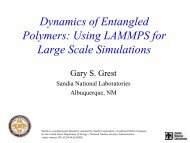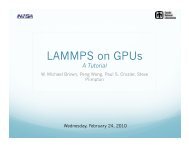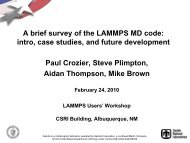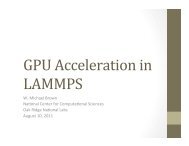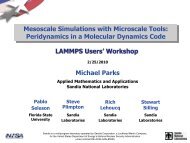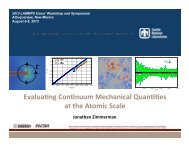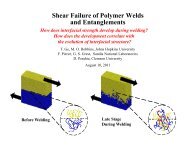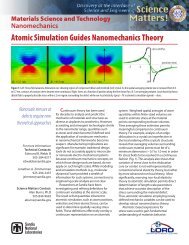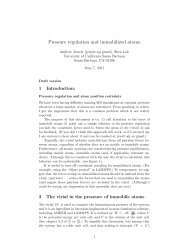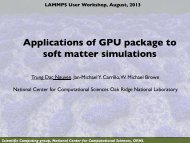A review of pseudorandom number generators - Lammps
A review of pseudorandom number generators - Lammps
A review of pseudorandom number generators - Lammps
You also want an ePaper? Increase the reach of your titles
YUMPU automatically turns print PDFs into web optimized ePapers that Google loves.
332 F. James / A <strong>review</strong> <strong>of</strong><strong>pseudorandom</strong> <strong>number</strong> <strong>generators</strong><br />
6. Efficiency. This was considered very important in the early days, but with the kind <strong>of</strong> computations<br />
being performed now, both the computer time and memory space taken by random <strong>number</strong> generation are<br />
increasingly insignificant and can almost always be neglected. In fact, the way random <strong>number</strong> <strong>generators</strong><br />
are traditionally implemented, as Fortran functions returning one random <strong>number</strong> per call, the CPU time<br />
is usually dominated by the time to make the function call, so the actual calculation time for the<br />
generation is seldom <strong>of</strong> any importance.<br />
If CPU time for random <strong>number</strong> generation is a problem, there are only two ways to get around it: (1)<br />
by coding the random <strong>number</strong> generator inline, or (2) by implementing the generator as a subroutine<br />
which returns an array <strong>of</strong> random <strong>number</strong>s at each call. Method (1) may be worthwhile in specialized<br />
applications, but may not be convenient in big programs where the random generator is called from many<br />
places. Method (2) is always to be recommended since the penalty to the user who can handle only one<br />
<strong>number</strong> at a time is small compared with the gain to the clever user.<br />
Moreover, it is important to note that in vector computers, even if the time spent in the generator is<br />
negligible, the above techniques can still result in enormous overall timing improvements, since otherwise a call<br />
to the random generator in a loop will prevent any vectorization <strong>of</strong> the ioop.<br />
1.4. Manufacturer-supplied <strong>generators</strong><br />
It has been traditional to use <strong>pseudorandom</strong> <strong>number</strong> <strong>generators</strong> supplied by the manufacturers <strong>of</strong> the<br />
local computer. There are many reasons for this, but most <strong>of</strong> them are no longer valid. The main reason<br />
was probably blind faith in the superior technical expertise <strong>of</strong> the manufacturer and the belief that a good<br />
generator must be written in assembler and exploit particular hardware features <strong>of</strong> the machine in order to<br />
be efficient. Many users are also influenced by the vague feeling that a sequence can be random only if it is<br />
produced in a mysterious way, coded in an unknown language whose source is not available.<br />
Given the current state <strong>of</strong> the art, there is practically no reason to use manufacturer’s s<strong>of</strong>tware for<br />
random <strong>number</strong> generation, the possible exception being those (supercomputers) which <strong>of</strong>fer good<br />
<strong>generators</strong> and compilers which produce in-line code. On the other hand, even better (but not faster)<br />
<strong>generators</strong> are now available to anyone in Fortran, <strong>of</strong>fering in addition portability, which no manufacturer<br />
<strong>of</strong>fers.<br />
2. Pseudorandom <strong>number</strong>s<br />
These are the general-purpose random <strong>number</strong>s traditionally used for most Monte Carlo calculations.<br />
2.1. Testing good distributions<br />
Zaremba [1] has pointed out that<br />
As far as <strong>pseudorandom</strong> <strong>number</strong>s are concerned, the traditional term “tests <strong>of</strong> randomness” is a<br />
misnomer. Surely, in contrast to their name, the object <strong>of</strong> such tests is not the random origin <strong>of</strong> the<br />
sequences, since this would amount to testing a hypothesis known to be false.<br />
Indeed, <strong>pseudorandom</strong> <strong>number</strong>s are not truly random, and it turns out to be very difficult if not<br />
impossible to make a mathematically rigorous definition <strong>of</strong> <strong>pseudorandom</strong>ness (See, for example, Knuth<br />
[2] who has a good discussion <strong>of</strong> this philosophical point).<br />
Nevertheless, we somehow have to express the fact that <strong>pseudorandom</strong> <strong>number</strong>s should appear to be<br />
truly random, even if they are not, and for want <strong>of</strong> a better word, we shall call this property<br />
“randomness”, not to be confused with the more usual definition, used for example by Zaremba, which we



